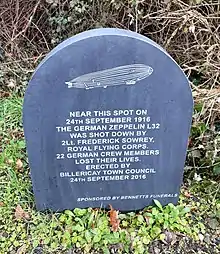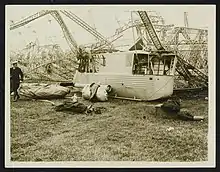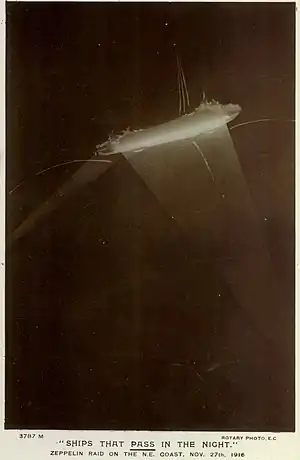Zeppelin LZ 74
LZ 74 (navy designation L 32) was an R Class super-zeppelin belonging to the Imperial German Navy.
| LZ 74 (L 32) | |
|---|---|
 | |
| The Zeppelin LZ 74 (L 32) memorial shaft (right front) in Saint Giles Churchyard. | |
| Type | Zeppelin R Class |
| Construction number | LZ 74 |
| Serial | L 32 |
| First flight | 4 August 1916 |
| Owners and operators | Imperial German Navy |
| Last flight | 24 September 1916 |
| Fate | Shot down on 24 September 1916 by 2nd Lt Frederick Sowrey |
Missions
The airship took part in three attacks on England dropping 6,860 kg (15,120 lb) of bombs.

Destroyed
On its final mission LZ 74 was commanded by Kapitan-Leutnant Werner Petersen. The Airship set out with LZ 72, LZ 76 and LZ 78 part of Zeppelin raid on the night of 23 September 1916.
Second Lieutenant Frederick Sowrey, of 39 Home Defence Squadron, in a Royal Aircraft Factory BE.2C, launched from Sutton Farm at 23:30 hours to patrol toward Joyce Green. Flying at 13,000 feet (4,000 m), he spotted Zeppelin LZ 74 at about 0110 hours. He was able to close in with the Zeppelin until he was close enough to fire three drums of incendiary ammunition into its belly. Round after round hit the Airship before it finally exploded in flame. There were no survivors from the aircrew; most of the bodies recovered were charred and burned. The burning wreckage of L 32 fell into farm fields off Green Farm Lane in Great Burstead, crashing at 01.30. The site drew enormous crowds.[1] The crew's bodies (22 in total) were buried at Great Burstead Church under 1 mile from the crash site, being buried on the 27th of September 1916, then exhumed in 1966 and reburied at the German Military Cemetery Cannock Chase.[2]
Specifications (LZ 74 / Type R zeppelin)
Data from Zeppelin : rigid airships, 1893-1940[3]
General characteristics
- Crew: 17-19
- Capacity: 32,400 kg (71,430 lb) typical disposable load
- Length: 198 m (649 ft 7 in)
- Diameter: 23.9 m (78 ft 5 in) maximum
- Fineness ratio: 8.24
- Volume: 55,200 m3 (1,950,000 cu ft) in 19 gas cells
- Empty weight: 31,400 kg (69,225 lb)
- Gross weight: 32,908 kg (72,550 lb)
- Fuel capacity: 6,250 kg (13,779 lb)
- Useful lift: 63,800 kg (140,700 lb)
- Powerplant: 5 × Maybach HS Lu 6-cylinder water-cooled in-line piston engines, 180 kW (240 hp) each
- Propellers: 4-bladed Lorenzen fixed-pitch propellers
Performance
- Maximum speed: 103 km/h (64 mph, 56 kn)
- Cruise speed: 81 km/h (50 mph, 44 kn)
- Range: 7,400 km (4,600 mi, 4,000 nmi) at 81 km/h (50 mph; 44 kn)
- Service ceiling: 3,900 m (12,800 ft) static
- Rate of climb: 10 m/s (2,000 ft/min) maximum permitted (r-class)
Armament
- Guns: machine-guns in hull-top positions and gondolas
- Bombs: up to 60 bombs to a total of 5,000 kg (11,023 lb)
Dirigibles shot down over the UK
Airships made about 51 bombing raids on Britain during the war. These killed 557 and injured another 1,358 people. More than 5,000 bombs were dropped (largely on towns and cities) across Britain, causing £1.5 million (equivalent to £108,200,000 in 2021) in damage. 84 airships took part, of which 30 were shot down or lost in accidents.[4]
| Zeppelins shot down over the UK | |||||||||||||||||||||||||||||||||||||||||||||||||||||||||||||||||||||||||||||||||
|---|---|---|---|---|---|---|---|---|---|---|---|---|---|---|---|---|---|---|---|---|---|---|---|---|---|---|---|---|---|---|---|---|---|---|---|---|---|---|---|---|---|---|---|---|---|---|---|---|---|---|---|---|---|---|---|---|---|---|---|---|---|---|---|---|---|---|---|---|---|---|---|---|---|---|---|---|---|---|---|---|---|
|
References
- Parsons, Les; Battams, Samantha (2019). The Red Devil: The story of South Australian aviation pioneer, Captain Harry Butler, AFC. Wakefield Press. p. 43. ISBN 9781743056721.
- Bowman, Martin W. (2017). Voices in Flight: Escaping Soldiers and Airmen of World War I. Casemate Publishers. ISBN 9781473863248.
- Brooks, Peter W. (1992). Zeppelin : rigid airships, 1893-1940. Washington, D.C.: Smithsonian Institution Press. pp. 95–99. ISBN 1560982284.
- Liddell Hart 1934, p. 76.
- Liddell Hart, Sir Basil Henry (1934). A History of the World War 1914–1918. Faber. ISBN 978-0-304-93653-3.


.jpg.webp)


